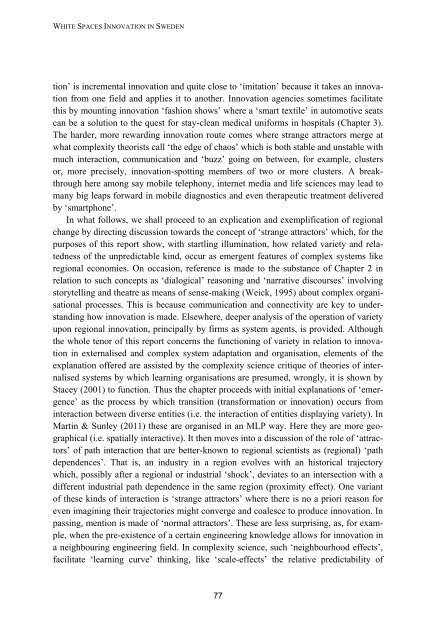White Spaces Innovation in Sweden - Innovation policy for ... - Vinnova
White Spaces Innovation in Sweden - Innovation policy for ... - Vinnova
White Spaces Innovation in Sweden - Innovation policy for ... - Vinnova
Create successful ePaper yourself
Turn your PDF publications into a flip-book with our unique Google optimized e-Paper software.
WHITE SPACES INNOVATION IN SWEDENtion‟ is <strong>in</strong>cremental <strong>in</strong>novation and quite close to „imitation‟ because it takes an <strong>in</strong>novationfrom one field and applies it to another. <strong>Innovation</strong> agencies sometimes facilitatethis by mount<strong>in</strong>g <strong>in</strong>novation „fashion shows‟ where a „smart textile‟ <strong>in</strong> automotive seatscan be a solution to the quest <strong>for</strong> stay-clean medical uni<strong>for</strong>ms <strong>in</strong> hospitals (Chapter 3).The harder, more reward<strong>in</strong>g <strong>in</strong>novation route comes where strange attractors merge atwhat complexity theorists call „the edge of chaos‟ which is both stable and unstable withmuch <strong>in</strong>teraction, communication and „buzz‟ go<strong>in</strong>g on between, <strong>for</strong> example, clustersor, more precisely, <strong>in</strong>novation-spott<strong>in</strong>g members of two or more clusters. A breakthroughhere among say mobile telephony, <strong>in</strong>ternet media and life sciences may lead tomany big leaps <strong>for</strong>ward <strong>in</strong> mobile diagnostics and even therapeutic treatment deliveredby „smartphone‟.In what follows, we shall proceed to an explication and exemplification of regionalchange by direct<strong>in</strong>g discussion towards the concept of „strange attractors‟ which, <strong>for</strong> thepurposes of this report show, with startl<strong>in</strong>g illum<strong>in</strong>ation, how related variety and relatednessof the unpredictable k<strong>in</strong>d, occur as emergent features of complex systems likeregional economies. On occasion, reference is made to the substance of Chapter 2 <strong>in</strong>relation to such concepts as „dialogical‟ reason<strong>in</strong>g and „narrative discourses‟ <strong>in</strong>volv<strong>in</strong>gstorytell<strong>in</strong>g and theatre as means of sense-mak<strong>in</strong>g (Weick, 1995) about complex organisationalprocesses. This is because communication and connectivity are key to understand<strong>in</strong>ghow <strong>in</strong>novation is made. Elsewhere, deeper analysis of the operation of varietyupon regional <strong>in</strong>novation, pr<strong>in</strong>cipally by firms as system agents, is provided. Althoughthe whole tenor of this report concerns the function<strong>in</strong>g of variety <strong>in</strong> relation to <strong>in</strong>novation<strong>in</strong> externalised and complex system adaptation and organisation, elements of theexplanation offered are assisted by the complexity science critique of theories of <strong>in</strong>ternalisedsystems by which learn<strong>in</strong>g organisations are presumed, wrongly, it is shown byStacey (2001) to function. Thus the chapter proceeds with <strong>in</strong>itial explanations of „emergence‟as the process by which transition (trans<strong>for</strong>mation or <strong>in</strong>novation) occurs from<strong>in</strong>teraction between diverse entities (i.e. the <strong>in</strong>teraction of entities display<strong>in</strong>g variety). InMart<strong>in</strong> & Sunley (2011) these are organised <strong>in</strong> an MLP way. Here they are more geographical(i.e. spatially <strong>in</strong>teractive). It then moves <strong>in</strong>to a discussion of the role of „attractors‟of path <strong>in</strong>teraction that are better-known to regional scientists as (regional) „pathdependences‟. That is, an <strong>in</strong>dustry <strong>in</strong> a region evolves with an historical trajectorywhich, possibly after a regional or <strong>in</strong>dustrial „shock‟, deviates to an <strong>in</strong>tersection with adifferent <strong>in</strong>dustrial path dependence <strong>in</strong> the same region (proximity effect). One variantof these k<strong>in</strong>ds of <strong>in</strong>teraction is „strange attractors‟ where there is no a priori reason <strong>for</strong>even imag<strong>in</strong><strong>in</strong>g their trajectories might converge and coalesce to produce <strong>in</strong>novation. Inpass<strong>in</strong>g, mention is made of „normal attractors‟. These are less surpris<strong>in</strong>g, as, <strong>for</strong> example,when the pre-existence of a certa<strong>in</strong> eng<strong>in</strong>eer<strong>in</strong>g knowledge allows <strong>for</strong> <strong>in</strong>novation <strong>in</strong>a neighbour<strong>in</strong>g eng<strong>in</strong>eer<strong>in</strong>g field. In complexity science, such „neighbourhood effects‟,facilitate „learn<strong>in</strong>g curve‟ th<strong>in</strong>k<strong>in</strong>g, like „scale-effects‟ the relative predictability of77
















